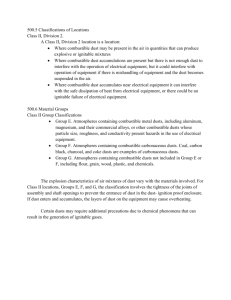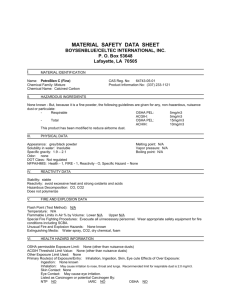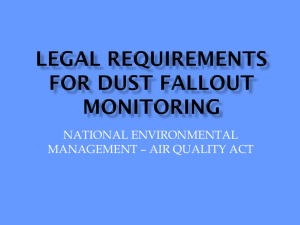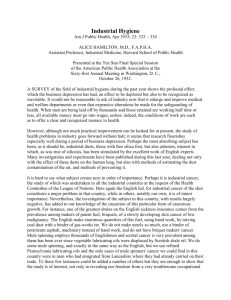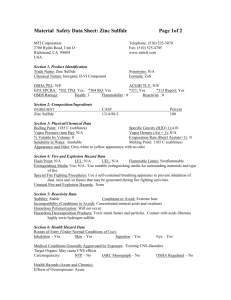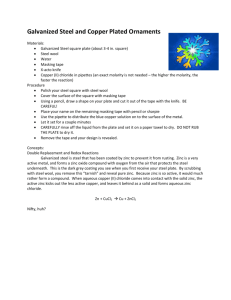Session8 Paper2
advertisement
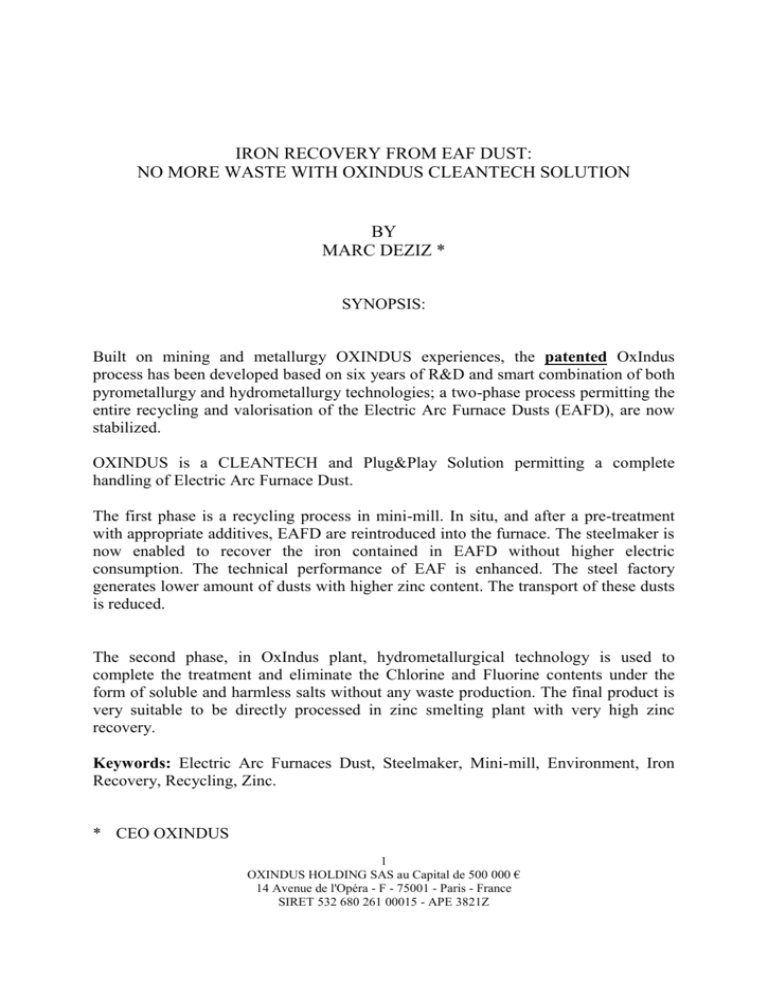
IRON RECOVERY FROM EAF DUST: NO MORE WASTE WITH OXINDUS CLEANTECH SOLUTION BY MARC DEZIZ * SYNOPSIS: Built on mining and metallurgy OXINDUS experiences, the patented OxIndus process has been developed based on six years of R&D and smart combination of both pyrometallurgy and hydrometallurgy technologies; a two-phase process permitting the entire recycling and valorisation of the Electric Arc Furnace Dusts (EAFD), are now stabilized. OXINDUS is a CLEANTECH and Plug&Play Solution permitting a complete handling of Electric Arc Furnace Dust. The first phase is a recycling process in mini-mill. In situ, and after a pre-treatment with appropriate additives, EAFD are reintroduced into the furnace. The steelmaker is now enabled to recover the iron contained in EAFD without higher electric consumption. The technical performance of EAF is enhanced. The steel factory generates lower amount of dusts with higher zinc content. The transport of these dusts is reduced. The second phase, in OxIndus plant, hydrometallurgical technology is used to complete the treatment and eliminate the Chlorine and Fluorine contents under the form of soluble and harmless salts without any waste production. The final product is very suitable to be directly processed in zinc smelting plant with very high zinc recovery. Keywords: Electric Arc Furnaces Dust, Steelmaker, Mini-mill, Environment, Iron Recovery, Recycling, Zinc. * CEO OXINDUS 1 OXINDUS HOLDING SAS au Capital de 500 000 € 14 Avenue de l'Opéra - F - 75001 - Paris - France SIRET 532 680 261 00015 - APE 3821Z Iron Recovery From EAF Dust: No More Waste With OxIndus Recycling Technology Introduction For many decades, Electric Arc Furnace Dusts (EAF Dusts) have been one of the main issues for steelmakers. Some incomplete solutions exist, but until now, no solution offers an entire and clean treatment of this waste. Besides, as current situation for steel producer is getting more and more difficult notably due to the rising electricity price tough competition with bigger countries such as China; extracting entire value from by-products has become a major concern for them. EAFD are a toxic waste but also represent a big loss for steel production. For one ton of steel produced, between 1.5% and 2.5% (depending of each plant) of dust is generated, and these dusts contain between 20% and 50% of iron; up to 1% of steelmaker purchases. Many decades ago, one of the solutions was landfilling of the waste. But this solution was particularly harmful for the environment and today is no longer authorized. Until now, few solutions had been developed, in order to try to recover the value (iron, zinc, other heavy metals) contained in the EAF Dusts. The most known are the Waelz process, the Rotary Hearth Furnace and the Primus process. Although the aim is to recover iron or zinc contained in the dust, these processes still produce an important part of wastes, which are not reusable in any industry. Moreover, all of these solutions require a huge investment from several dozen of millions US Dollars, and need important operating expenditure. The Technology developed by OxIndus combines complete and clean value extracted from EAFD with additional revenues and no operating cost for steel factory. 2 OXINDUS HOLDING SAS au Capital de 500 000 € 14 Avenue de l'Opéra - F - 75001 - Paris - France SIRET 532 680 261 00015 - APE 3821Z Materials and Methods The OxIndus process consists of two separate stages: the first stage, BLACK LINE, takes place in the steelworks, under the supervision of OxIndus and in collaboration with the company (steelmaker), is based on pyrometallurgy. The second step, WHITE LINE, in a dedicated plant, uses hydrometallurgical technology to clean out halogen’s content from the dusts. FIRST PHASE: BLACK LINE The first phase, pyrometallurgy, does not need any additional and specific furnace. Indeed Black Line process uses the very Electric Arc Furnace of the steel factory where dusts are generated, but doesn’t consume any Electric energy given to the furnace. Before being recycled, the dusts are condensed into pellets (briquettes) together with the suitable percentage of additives (carbon based reducing agent and alkali based additives) according to the specific composition of the EAFD. Then, the briquettes are processed within the mini-mill furnace along with the primary materials (scrap). The energy needed to process and melt briquettes introduced into the furnace is given by the carbon based additive added inside the briquettes. One recurrent problem for steel factory is dusts emission. The implementation of Black Line process does not only imply no additional flying dust within steel maker premises but also sharply reduce the global amount of dusts that was before discharged to the environment. To achieve these goals, we must have thought to (i) avoid long distance transportation of dusts and (ii) reduce the material tendency to generate flying dust while being handled. The equipment developed by OxIndus is compact, mobile and can easily be implemented next to the filtration system, reducing the potential amount of flying dust emitted during dusts transportation. Besides, dusts are handled inside a closed chamber/building that has dedusting and filtration system, where collected dust will be recycled into the Black line process. Also, the dusts are transported within closed bins. Once produced, the dusts briquettes are transported to the furnace only when their consistency is strong enough to suppress dust emission to the environment. The shape of the briquettes has also been chosen to reduce its breakdown potential. The mobile and compact dust treatment unit is called the Briquetting Unit. This Unit operates with the highest QHSE standards and complies with CE marking, ISO 9000, ISO 14000 and OSHAS. This Unit is easy to operate, while only one worker can run the treatment unit. 3 OXINDUS HOLDING SAS au Capital de 500 000 € 14 Avenue de l'Opéra - F - 75001 - Paris - France SIRET 532 680 261 00015 - APE 3821Z This Black Line process maximizes the use of recycling methods. Among them the innovative dedusting system onto the Briquetting Unit is an air washer system where water is reused until being finally entirely introduced into the process as an additive. Figure 1: Black Line process Regarding the chemical aspect, additives natures and contents are essential for efficiency of recycling and Iron recovery for the steel maker. The flexible treatment unit is easily and rapidly adjusted taking into account the initial composition of EAFD and specificities of the steelmaking process. After Black Line process implementation, the dusts produced within your premise are less concentrated in Iron and more in Zinc. A part of these dusts, Raw-OxIndus, are then safely transported toward the second step of OxIndus Technology. 4 OXINDUS HOLDING SAS au Capital de 500 000 € 14 Avenue de l'Opéra - F - 75001 - Paris - France SIRET 532 680 261 00015 - APE 3821Z SECOND PHASE: WHITE LINE The second phase of the OxIndus Technology gathered the processed dusts (Raw-OxIndus) from several steel factories toward one treatment plant. It consists in a hydro-dechloruration and hydro-defluoration treatment in a basic medium, which is low cost, low-energy and non-polluting. This plant could be break down into storage facilities for Raw-OxIndus to be treated, mixing equipments where dusts are put together with water and under basic condition, and filtration equipments where dust are separated from water; the later is a clean one and only contains harmless salts such as sea salts. The end product, OxIndus, is easily workable for Zinc Industry (smelters…) and enables to reach a zinc recovery up to 98%. Mixing and filtration process need to be strictly controlled with online pH measurements to remain between a tight ranges of pH and prevent any heavy metals leaching with water. OxIndus White Line Plant has its own industrial wastewater treatment facilities to comply with all effluent discharge standards whatever will be the country. The White Line process, and OxIndus technology in general, doesn’t produce any waste. Figure 2: White Line plant 5 OXINDUS HOLDING SAS au Capital de 500 000 € 14 Avenue de l'Opéra - F - 75001 - Paris - France SIRET 532 680 261 00015 - APE 3821Z The equipments and plant design are flexible. Indeed, the White Line treatment capacity could be easily adjust with the increasing amount of material to be treated; for example, by adding a treatment line in the same building to double the capacity. The nominal treatment capacity of the White Line plant is between 50 000 and 100 000 MT. Results and discussion FIRST PHASE: BLACK LINE The energy brought by the reducing agent C (carbon) is used in the furnace to vaporize Zinc and Lead, raise the temperature of all EAFD elements, etc. and induces a complex chemical-physical exothermic mechanism, that brings more heat to the furnace and does not take any heat away from the system. Energy studies have proven that when such briquettes are reintroduced together with the load of scrap in the furnace, there is no extra electric consumption from the furnace. While volatile elements such as Zinc, Lead, etc. contained in the recycled EAFD will entirely go with the exhaust fumes, and the iron contained in the recycled EAFD will go with the liquid steel, the composition of new dusts produced in the furnace will change. These dusts will enrich in Zinc (up to 42%) and Lead, and will impoverish in Iron (only 8-12 %). The new product is called “Raw OxIndus”. The following chart compares EAFD elementary composition with Raw OxIndus elementary composition: Chart 1: Comparative compositions between EAFD and Raw OxIndus 6 OXINDUS HOLDING SAS au Capital de 500 000 € 14 Avenue de l'Opéra - F - 75001 - Paris - France SIRET 532 680 261 00015 - APE 3821Z Besides, the fact to reintroduce the dust into the furnace leads up to 40% reduction of dust volume that comes out from the steel factory premises. This is principally due to the Iron content that is recovered with the liquid steel. “Reducing the amount of waste produced” is the very first criteria for every waste management policy. This reduction leads to a reduction in material transportation, and positively impact the environment: less green house effect emissions. The results at the end of the stage are the following: - Reducing the amount of EAFD generated - Recovery of 50 - 75% of Iron (Fe) which would be otherwise lost in the waste – about 9 or 10 kg per ton of initial load in EAF - Up to 1% increase in technical performance of your steel making process - Reducing the volume of material transported - Increase of Zinc and Lead contents in the dusts - Increase of Chlorine, Fluorine, Sodium, Potassium, etc. contents in the dusts SECOND PHASE: WHITE LINE As explained above, Raw OxIndus has higher chlorine and fluorine content than EAFD. For this reason, Raw OxIndus can’t be benefited as an industrial direct and sustainable use. It has to receive the second part of the treatment in the White Line. Indeed, Chlorine (Cl) is a problematic element present in EAFD and a source of numerous industrial and environmental problems. The chlorine ion is very reactive; it quickly bonds with other elements to form aggressive compounds that eventually deteriorate the tanks, pipes and other parts of the production chain they come in contact with. Moreover, these aggressive compounds highly contribute to global pollution by ending up in the water evacuated by the plants. The hydro-dechloruration and hydro-defluoration treatment in a basic medium enables to obtain: - a solid cleaned from Chlorine and whose Fluorine content had been sharply decreases, and - a water loaded with Chlorine, Fluorine and their associated counter ions Sodium and Potassium: NaCl, NaF, KCl, KF… The solid has a Zinc content up to 50 % could be directly exported and used by Zinc smelter as a Zinc Oxide Concentrate, called OxIndus. NB: 50 % Zn content represents a Zinc Oxide content of 62%. 7 OXINDUS HOLDING SAS au Capital de 500 000 € 14 Avenue de l'Opéra - F - 75001 - Paris - France SIRET 532 680 261 00015 - APE 3821Z Here under is a typical analysis of the Zinc Oxide “OxIndus” produced: Element OxIndus Zinc Zn 44 to 50 % Lead Pb 6 to 10 % Iron Fe 8 to 15 % Fluorine F Divided per 2 Chlorine Cl < 0,015 % Potassium K < 0,015 % Calcium Ca 1 to 3 % Silicon Si 0,5 to 1,5 % Sodium Na < 0,015 % Chart 2: Elementary composition of Zinc Oxide Concentrate: “OxIndus” The liquid effluent is not waste; it is only salt water. Here under is the analysis of White Line liquid effluent before the final treatment before discharge into the receiving environment. Unit Discharge water pH 8.1 Zn mg/l 0.4 Pb mg/l <0.4 Fe mg/l 0.3 Cu mg/l 0.3 Cd mg/l <0.4 Sn mg/l <0.4 Ti mg/l <0.2 V mg/l <0.2 Mn mg/l <0.2 Na g/l 5.5 K g/l 3.5 Ca mg/l 220 Mg mg/l <4.0 Al mg/l 0.6 Si mg/l <12 Cl g/l 6.9 F mg/l 33 Chart 3: Analysis of water discharge from White Line plant The OxIndus technology is a Zero Waste Technology. 8 OXINDUS HOLDING SAS au Capital de 500 000 € 14 Avenue de l'Opéra - F - 75001 - Paris - France SIRET 532 680 261 00015 - APE 3821Z
